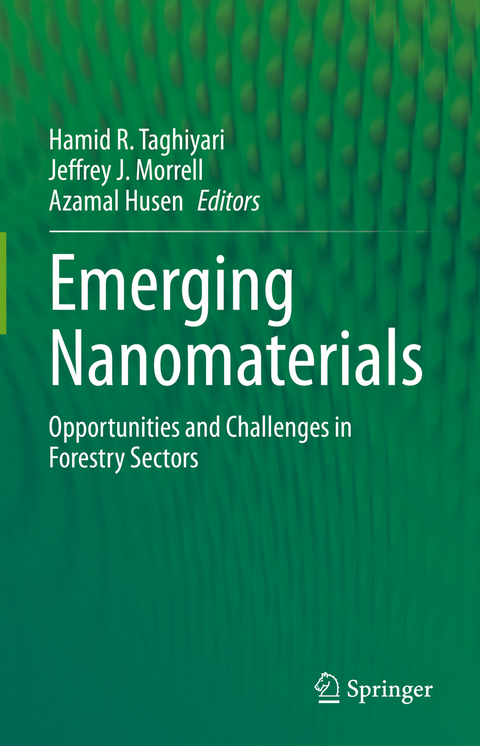
Emerging Nanomaterials
Springer International Publishing (Verlag)
978-3-031-17377-6 (ISBN)
lt;p> Hamid R. Taghiyari main area of expertise is fluid flow and permeability in wood and wood-based composites, wood modification techniques, and utilization of nanomaterials in wood and wood-based composites. He has intensively worked on the effects of different nanomaterials on properties of solid wood (different species), and composite panels as well, over the last two decades. The nanomaterials he worked with started with nanometals (including silver, copper, zinc oxide); soon he turned to minerals as they are more abundant, cheaper, and with lower environmental hazards. The results of his studies have been published in a wide range of academic journals. He had the privilege of mentoring over 40 post-graduate students, mainly on utilization of nanomaterials to improve different properties in solid wood, and wood-based composite panels as well, including physical and mechanical properties, fire retardants, and biological durability against wood-deteriorating fungi and insects.
Jeffrey J. Morrell holds BSc and PhD degrees form the State University of New York College of Environmental Science and Forestry in Forest Biology and Forest Pathology and Mycology, respectively, as well as an MSc from Pennsylvania State University in Plant Pathology (nematology). He has over 40 years of experience in the field of wood science concentrating on durability. His research has spanned the field from understanding the fungal sequences during decay to the use of various chemicals to minimize fungal attack and ultimately to the movement and fate of preservatives, especially in aquatic environments. He has been fortunate to mentor over 50 post-graduate students. He is currently Director of the National Centre for Timber Durability and Design Life at the University of the Sunshine Coast in Brisbane, Australia and is actively engaged in research related to enhancing the performance of cellulosic materials.
Azamal Husen served as Professor & Head, Department of Biology, University of Gondar, Ethiopia and is a Foreign Delegate at Wolaita Sodo University, Wolaita, Ethiopia. He specializes in biogenic nanomaterial fabrication and application, plant responses to environmental stresses and nanomaterials at the physiological, biochemical and molecular levels, herbal medicine, and clonal propagation for improvement of tree species, and has published over 175 research articles. He is contributed to R&D projects of World Bank, ICAR, ICFRE, JBIC etc. He is on the advisory board of Cambridge Scholars Publishing, UK. Husen has been on the Editorial Board and the panel of reviewers of several reputed journals. He is a Fellow of the Plantae group of the American Society of Plant Biologists, and a Member of the International Society of Root Research, Asian Council of Science Editors, and INPST. He is Editor-in-Chief of the American Journal of Plant Physiology, and a Series Editor of Exploring Medicinal Plants (Taylor & Francis Group, USA); Plant Biology, Sustainability, and Climate Change (Elsevier, USA); and Smart Nanomaterials Technology (Springer Nature, Singapore).
Preface.- Chapter. 1. Emerging nanomaterials for forestry and associated sectors: An overview.- Chapter. 2. Potential of Nanomaterials in Bio-Based Wood Adhesives: An Overview.- Chapter. 3. Nanomaterials to improve fire properties in wood and wood-based composite panels.- Chapter. 4. Wood Plastic Composites (WPC): Applications of Nanomaterials.- Chapter. 5. Nanomaterials to improve properties in wood-based composite panels.- Chapter. 6. Nanomaterials to improve the strength of wooden joints.- Chapter. 7. Application of nanomaterials for wood protection.- Chapter. 8. Nanocellulose in paper and board coating.- Chapter. 9. Green Materials for Radiation Shielding: An overview.- Chapter. 10. Formaldehyde emissions from wood-based composites: Effects of nanomaterials.
| Erscheinungsdatum | 07.12.2022 |
|---|---|
| Zusatzinfo | X, 362 p. 85 illus., 55 illus. in color. |
| Verlagsort | Cham |
| Sprache | englisch |
| Maße | 155 x 235 mm |
| Gewicht | 715 g |
| Themenwelt | Naturwissenschaften ► Biologie ► Ökologie / Naturschutz |
| Weitere Fachgebiete ► Land- / Forstwirtschaft / Fischerei | |
| Schlagworte | biomaterials • Coatings • composite materials • Forestry Products • nanomaterials • Panels |
| ISBN-10 | 3-031-17377-5 / 3031173775 |
| ISBN-13 | 978-3-031-17377-6 / 9783031173776 |
| Zustand | Neuware |
| Haben Sie eine Frage zum Produkt? |
aus dem Bereich


